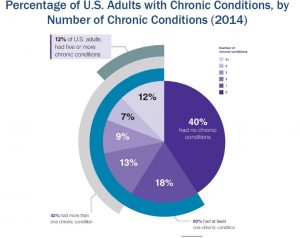Report on Chronic Health Conditions and Their Impact on Sustainable Development Goal 3
Introduction: Aligning Public Health with SDG 3 Targets
The prevalence of chronic, non-communicable diseases (NCDs) among adult populations presents a significant challenge to the achievement of Sustainable Development Goal 3 (SDG 3), which aims to ensure healthy lives and promote well-being for all at all ages. An analysis of common health conditions reveals critical areas requiring intervention to meet SDG Target 3.4, which calls for a one-third reduction in premature mortality from NCDs through prevention and treatment, and the promotion of mental health and well-being.
Prevalence of Non-Communicable Diseases (NCDs) by Age Group
Data from recent public health reports illustrate the scale of the challenge in managing NCDs, with prevalence rates varying across different adult age demographics.
- Adults in Midlife (Ages 35-64): A report on preventing chronic disease identifies the most common conditions as:
- Obesity (37%)
- High Cholesterol (37%)
- High Blood Pressure (35%)
- Older Adults (Ages 65+): The top three reported conditions shift with age:
- High Blood Pressure (61%)
- High Cholesterol (55%)
- Arthritis (51%)
- The Oldest Adults (Ages 85+): A separate CDC report confirms the high burden of NCDs in the most senior populations:
- High Blood Pressure (67%)
- Arthritis (56%)
- High Cholesterol (46%)
Underreported Conditions and Their Detrimental Effects on Well-being
Beyond the most frequently cited statistics, several other conditions significantly impact the well-being of older adults, directly affecting progress toward SDG 3.
Hearing Loss
- Prevalence: Affects approximately one-third of older adults, yet is often underreported due to social stigma and a perception that treatment is ineffective.
- Impact on SDG 3: Untreated hearing loss is a major barrier to well-being. It is linked to an increased risk for depression, dementia, social isolation, and falls, undermining the holistic health targets of SDG 3. Addressing this condition is crucial for promoting both physical and mental health.
Depression
- Prevalence: Affects nearly 20% of adults aged 35-64 and almost 15% of those 65 and older.
- Impact on SDG 3: The high prevalence of depression highlights the urgent need to integrate mental health services into primary care to meet SDG Target 3.4. Diagnosis in older adults can be complex, as symptoms may present atypically (e.g., excessive sleep, anhedonia), requiring greater awareness and specialized care.
Emerging Health Challenges in an Aging Population
Advances in healthcare have led to increased longevity, which in turn presents new challenges for achieving SDG 3 across the entire lifespan.
Dementia
- Prevalence: While rare in midlife, dementia becomes a significant concern in advanced age, with an estimated 12% of adults 85 and older affected.
- Impact on SDG 3: The rise in dementia cases is linked to greater success in managing other fatal conditions like heart disease. This demographic shift necessitates a greater focus on neurological and cognitive health to ensure that longer lives are also healthy lives, in full alignment with the principles of SDG 3.
Analysis of SDGs in the Article
1. Which SDGs are addressed or connected to the issues highlighted in the article?
-
SDG 3: Good Health and Well-being
The entire article is dedicated to discussing the prevalence of chronic health conditions and mental health issues among adults, particularly those over 50. It focuses on non-communicable diseases (NCDs) like high blood pressure, high cholesterol, obesity, and arthritis, as well as mental and neurological conditions such as depression and dementia. This directly aligns with SDG 3’s mission to “ensure healthy lives and promote well-being for all at all ages.”
2. What specific targets under those SDGs can be identified based on the article’s content?
-
Target 3.4: By 2030, reduce by one third premature mortality from non-communicable diseases through prevention and treatment and promote mental health and well-being.
The article directly addresses this target by highlighting the high prevalence of major non-communicable diseases and mental health conditions. It lists specific NCDs such as “obesity (37 percent), high cholesterol (37 percent), and high blood pressure (35 percent)” in midlife adults, and “blood pressure (61 percent), high cholesterol (55 percent) and arthritis (51 percent)” in older adults. Furthermore, it discusses mental health by noting the prevalence of “depression, which affects nearly 20 percent of adults ages 35 to 64” and dementia, which affects “an estimated 12 percent of adults 85 and older.” The discussion of these conditions is central to the prevention and treatment efforts mentioned in Target 3.4.
-
Target 3.8: Achieve universal health coverage, including financial risk protection, access to quality essential health-care services and access to safe, effective, quality and affordable essential medicines and vaccines for all.
This target is implied through the discussion of barriers to treatment and the availability of care. The article notes that for hearing loss, “patients are often reluctant to discuss hearing troubles with their doctor” due to stigma. This reluctance points to a barrier in accessing necessary healthcare services. The mention of available treatments like “Hearing aids, medication and surgery” underscores the importance of access to quality and effective healthcare solutions, which is a core component of universal health coverage.
3. Are there any indicators mentioned or implied in the article that can be used to measure progress towards the identified targets?
Yes, the article provides specific data points that can serve as indicators to measure the prevalence of NCDs and mental health conditions, which is essential for tracking progress on Target 3.4.
-
Indicators for Target 3.4 (Prevalence of NCDs and Mental Health Conditions): The article provides numerous statistics that function as direct indicators.
- Prevalence of obesity in adults ages 35 to 64: 37 percent.
- Prevalence of high cholesterol in adults ages 35 to 64: 37 percent.
- Prevalence of high blood pressure in adults ages 35 to 64: 35 percent.
- Prevalence of high blood pressure in adults 65 and older: 61 percent.
- Prevalence of high cholesterol in adults 65 and older: 55 percent.
- Prevalence of arthritis in adults 65 and older: 51 percent.
- Prevalence of hearing loss in older adults: “about one-third”.
- Prevalence of depression in adults ages 35 to 64: “nearly 20 percent”.
- Prevalence of depression in people 65-plus: “nearly 15 percent”.
- Prevalence of dementia in adults 85 and older: “an estimated 12 percent”.
-
Implied Indicators for Target 3.8 (Access to Healthcare): The article implies an indicator related to healthcare access and utilization.
- The mention that patients are “reluctant to discuss hearing troubles” because of stigma suggests a gap in healthcare access. This implies an indicator such as the “Proportion of the population with a specific condition (e.g., hearing loss) who seek and receive treatment.” A low rate would indicate barriers to universal health coverage.
4. Table of SDGs, Targets, and Indicators
| SDGs | Targets | Indicators |
|---|---|---|
| SDG 3: Good Health and Well-being | 3.4: Reduce premature mortality from non-communicable diseases (NCDs) and promote mental health and well-being. |
|
| SDG 3: Good Health and Well-being | 3.8: Achieve universal health coverage and access to quality essential health-care services. |
|
Source: aarp.org







